
What do you think of when you hear Budapest? Ruin pubs and parties? The famous Hungarian spas? The magnificent Parliament building on the Danube? The horrors of 2 terror regimes?
One of the series I posted on my Instagram account Travelknowing, was exploring Budapest in a photo a day. We were in Budapest a total of 11 days – a terrific destination that’s not only the capital of Hungary and one of the largest cities in the European Union, but a fascinating and beautiful city to explore. Most of the photos in the series weren’t in my original blog post 8 Nights – no, Make that 11 – in Fascinating Budapest. Enjoy Budapest!
A Famous Ruin Pub – Szimpla Kert
Who doesn’t love a fun and funky bar? Even if the late night party scene isn’t your thing, you can still enjoy the lively Ruin Pub atmosphere of Szimpla Kert on a Sunday when the most famous of Budapest’s Ruin Pubs transforms into a bustling Farmer’s Market with all types of local products, complete with live music inside and out.
Szimpla Kert
Why’s it called a Ruin Pub? The ruin pubs are in the Jewish Quarter and in the decades after the devastation of WWII, the buildings here remained neglected and dilapidated even when other parts of the city were rejuvenated. In came the ruin pubs, bars built in and between the spaces of the ruined buildings and the first and quirkiest of them all is Szimpla Kert (Simple Garden) with lots of crazy rooms to explore. Don’t miss it!
Dohány Street Synagogue (Great Synagogue)
Not only is the Dohány Street Synagogue (Great Synagogue) an impressive building inside and out, it’s also a World Heritage site. The Moorish, almost Oriental decor evokes the Sephardic Jewish culture of Iberia, where many Hungarian Jews came from after being expelled from Spain in 1492.
Dohany Street Synagogue at night
The interesting tour is well worth it to learn about the history of the synagogue and why it looks so much like a church, complete with pulpit and organ, and of the terrible persecution and murder of the Hungarian Jews in WWII. What’s amazing is that this synagogue wasn’t destroyed by the Nazis, they used it for their own purposes. Check the Synagogue website for opening hours and plan your visit for one of the English language tour times…and take the tour!
Weeping Willow Sculpture at the Dohány Street Synagogue (Great Synagogue)
A weeping willow sculpture holds the names of countless Holocaust victims on silvery leaves in the Raoul Wallenburg Memorial Park in the rear courtyard of the Great Synagogue.
Weeping willow sculpture
Why was this memorial park named after a Swedish diplomat? He saved the lives of thousands of Hungarian Jews in the horrors of the Nazi era. You’ll have a much greater appreciation of the history if you get a chance to listen to (or read!) the wonderful book The Envoy by Alex Kershaw before you go to Budapest. Sadly, this hero’s own tragic death came about at the hands of the Soviet liberators of Budapest when he was detained on espionage suspicion and disappeared into an infamous Moscow prison.
Fisherman’s Bastion
The fantasy looking Fisherman’s Bastion was built as a panoramic view terrace behind Matthias Church, its ornate structure an homage to the Magyar tribes that settled Hungary in the 9th century, with 7 pointed towers representing the original 7 tribes.
Fishermans Bastion
It gets its name from the guild of fishermen who lived at the bottom of the hill and were responsible for defending the original rampart that was here. This is one of the best views in the city, plus the free walking tour ends here where you’re perfectly positioned to visit other sights on Castle Hill, like the highly recommended Hospital in the Rock!
Magyar Chieftains in Heroe’s Square
Árpád, along with the 6 other Magyar clan chieftains, are immortalized at the central column in the center of Heroes Square in Budapest. Wearing medieval chain mail, carrying heavy weapons, and astride their big powerful steeds….wait a minute!! These guys conquered Hungary way back in the 9th century, not the middle ages, and they came from Central Asia on fast little Mongolian steeds using agility, speed and quick firing bows that they shot directly from the saddle.
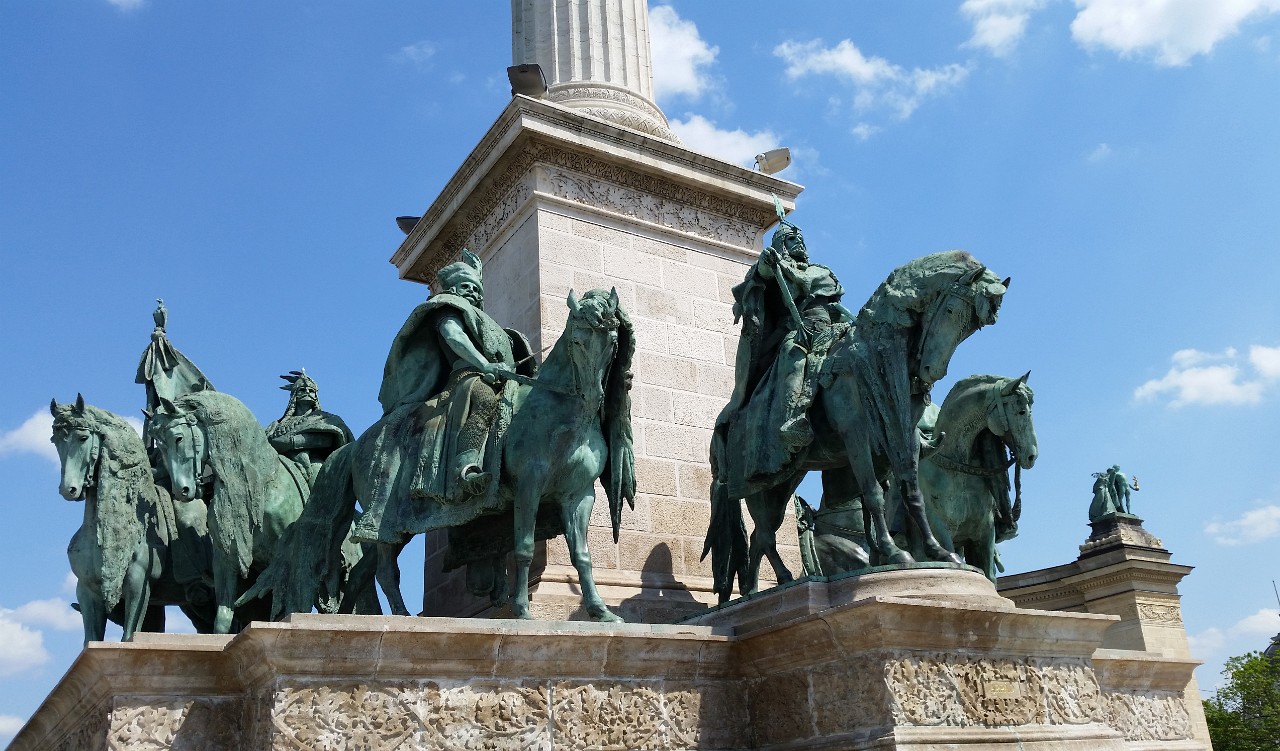
Heroes Square Magyar chieftains
Ah well, one feature that is authentic are the bushy mustaches! My favorite statue of the 7 is chief Huba whose horse has a huge set of antlers for a bridle, don’t miss a look at that one!
Széchenyi Thermal Baths
What is it? A beautiful Palace? A gorgeous Museum? No! It’s part of the front entrance of the enormous and beautiful 1913 neo-baroque Széchenyi Thermal Baths that face the city park.
Szechenyi Thermal Baths
Hot springs are all throughout Hungary, giving rise to the fantastic institution of medicinal bathing and with it’s 21 pools Széchenyi is one of the largest bath complexes in Europe…outdoor, indoor, whirlpool, spa, sauna, medicinal – something for everyone! My favorites? The lavender and menthol steam rooms. Ahhhhhh. What’s your favorite spa room?
Budapest Opera House
Do you love historic tours of famous buildings? The sumptuous interior of the 19th century Hungarian State Opera House has a reputation not just for the fabulous interior but is considered to be among the finest opera houses in the world.
Budapest Opera House stage
Funded by the city of Budapest and Emperor Franz Joseph, the Emperor’s only stipulation was that it was to be smaller than the one in Vienna – so yes it is smaller, but to his chagrin the opera house itself is much more ornate and lavishly decorated. Have you toured both Budapest’s and Vienna’s Opera House? Which one wins?
St. Istvan Basilica
In the center of Pest, Budapest’s biggest church St. Stephen’s Basilica is named for Hungary’s first Christian king St. István – the king who is considered one of the most important statesmen in the history of Hungary.
But what made this king a saint? Born a pagan with the name Vajk, he was baptized a Christian and took the name István (Stephen) – upon ascending to the throne he devoted much of his reign to the promotion of the Christian faith, crushing the pagan counterreaction to Christianity, beheading those who wouldn’t convert, and consolidating the Christian hold of the region.
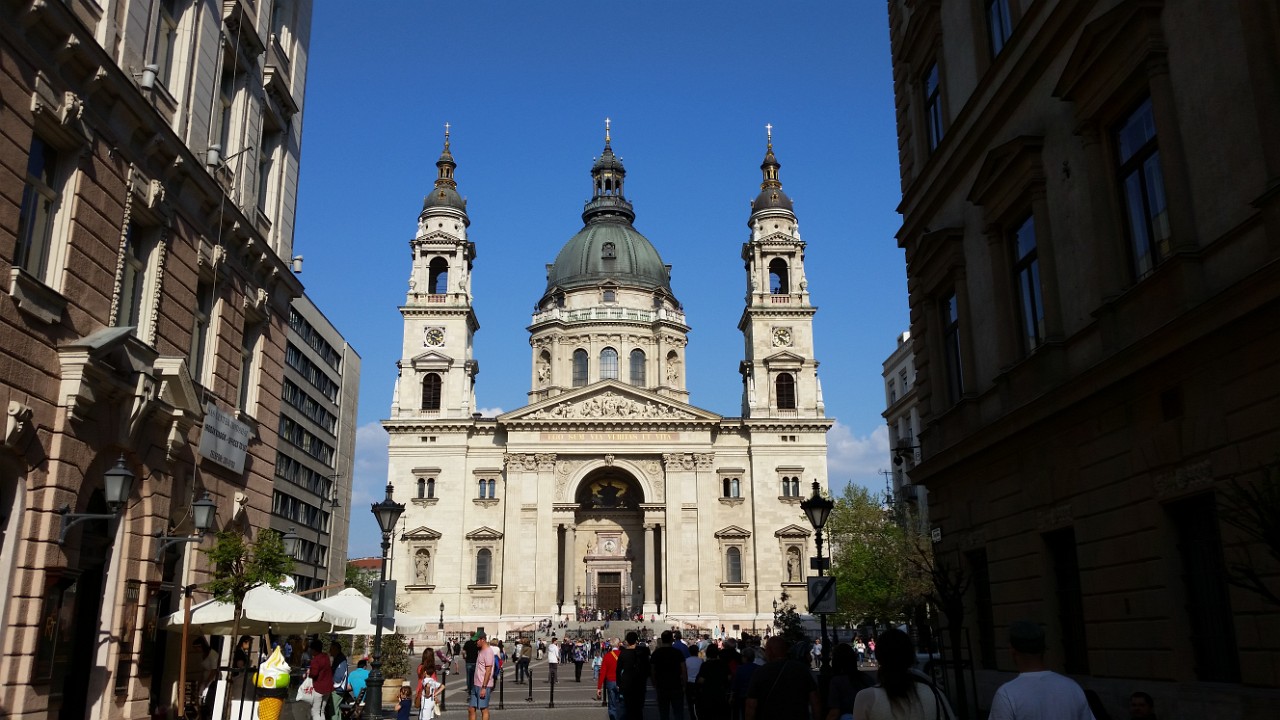
St Istvan Basilica facade
Canonized only 30 years after his death, St. Stephen the Great’s withered holy right hand is on display in a jeweled box in the chapel. The beautiful interior is definitely worth a look… the right hand? Hmmmm…ok sure!
Inside St. Stephen’s Basilica
In the dimly lit interior of the Basilica, the glowing figure under a canopy at the main altar isn’t Jesus, it’s St. István! It took special permission from the Pope in order to place his statue on the altar.
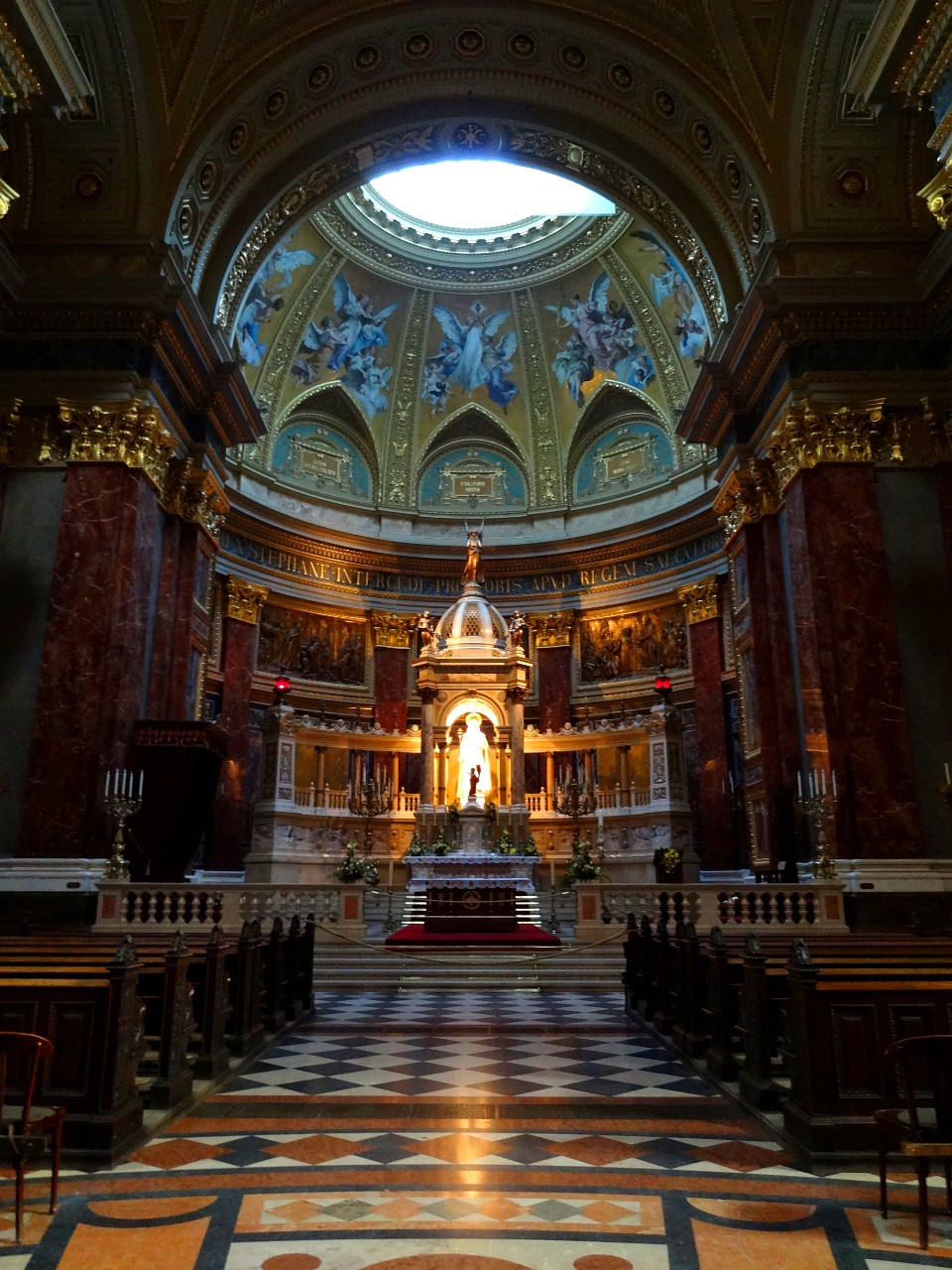
St Istvan Basilica Altar
Have you ever been to a church where the main altar had someone besides Jesus?
The Chain Bridge
Guarded by pairs of lions on each end (symbolizing power), the historic stone Chain Bridge was the very first to span the Danube between Buda and Pest. Although destroyed during the siege of Budapest in 1945 it was rebuilt just the way it was before only 4 years later.
Chain Bridge
A symbol of Budapest, a walk over and back is one of the things you have to do, both during the day AND at night to see the iconic bridge in all it’s night lit glory!
Budapest Parliament
The enormous and elegant Hungarian Parliament building, an icon of Budapest, was inspired by…the British Parliament in London! Built back in the days of the Austro-Hungarian empire, the size of the building reflected the size of the grand extent of the rule of much of Eastern Europe, but today only a small portion is used for politics.

Budapest Parliament
We viewed this magnificent building from all angles but we never did a tour of the interior, the times we passed by and ventured into the visitor center the tour times were always sold out. If you want to do a tour of what is supposed to be a magnificent interior, get your reservation on line well in advance!
Gellert Hill
Who likes to get out into nature in the middle of a city? And when a park comes with interesting monuments and fabulous views it’s perfect! The 771 foot high Gellért Hill is named after Saint Gerard who, in the great pagan rebellion of 1046 was put into a barrel and rolled down to his death.
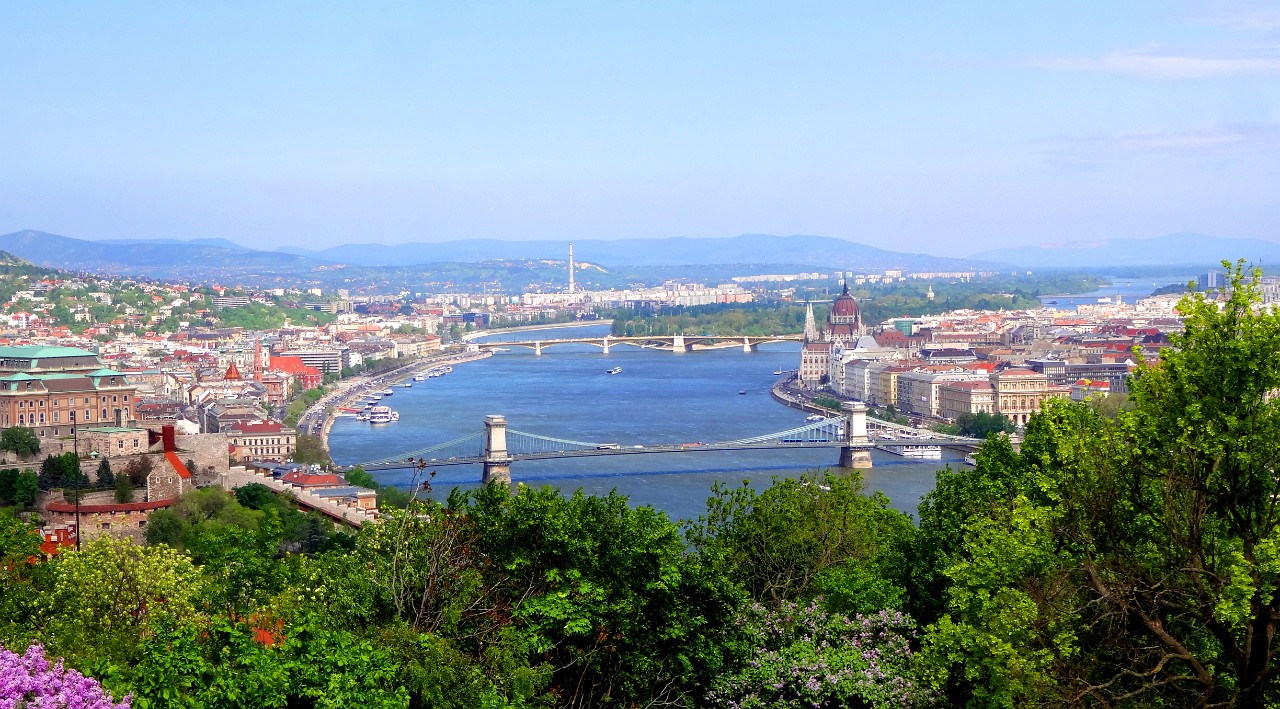
View from Gellert Hill
From Deák Ferenc square in the center of Pest, Gellért Hill looks pretty far away but it only took us 20 minutes to cross the Elizabeth Bridge and get to the viewpoint for this beautiful view of the Chain Bridge with the Parliament on one side and Royal Palace on the other.
St. George and the Dragon on top of Gellert Hill
There are interesting and symbolic monuments at the very top of Gellért Hill, like this one of Saint George slaying a dragon – but not just any St. George and dragon!
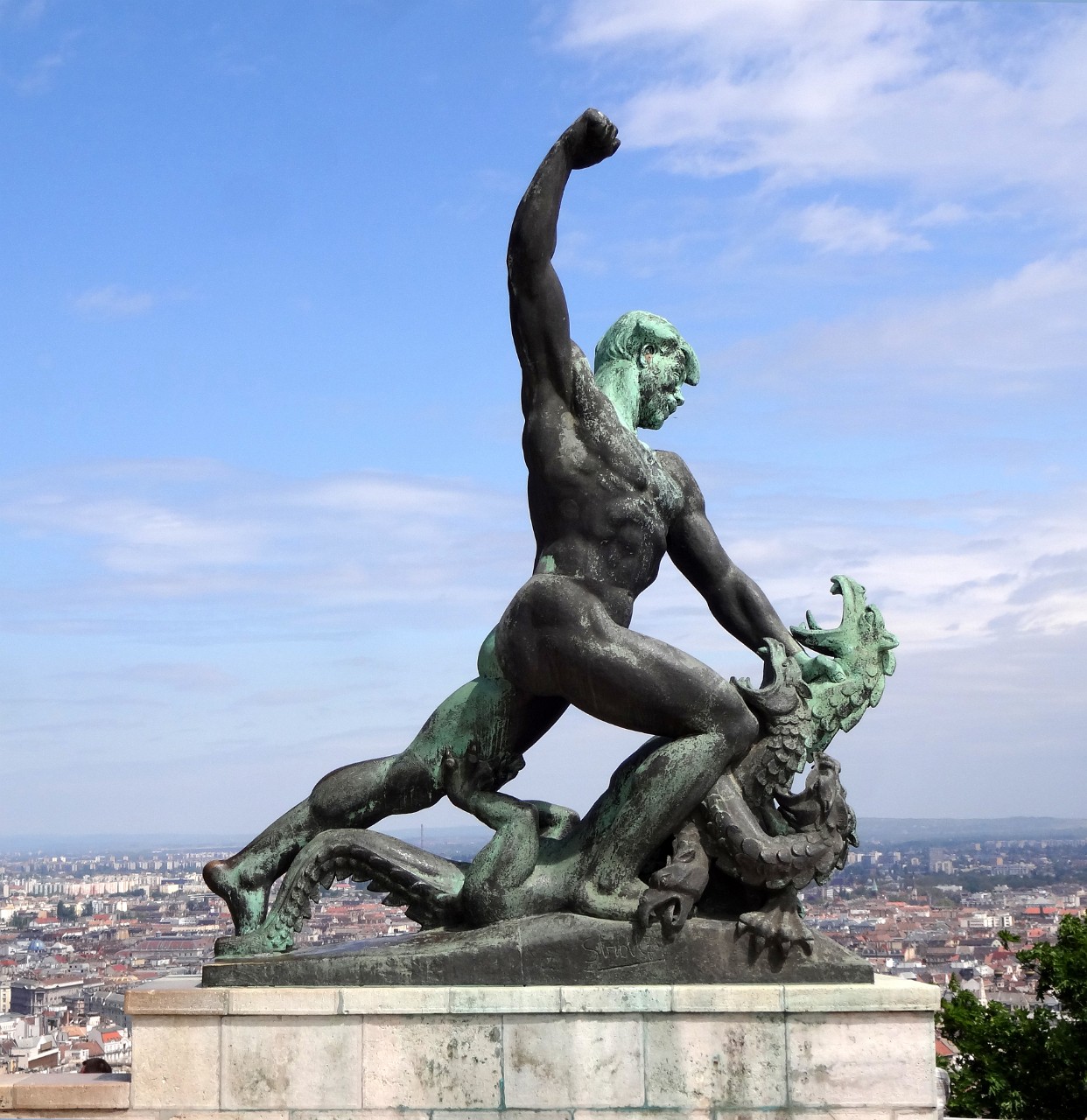
Gellert Hill St George statue
Very much a Socialist Realism statue, this heroic worker of a victorious St. George beats down the 3 headed dragon symbolizing Nazism – or is it the 3 isms of Nazism, Fascism and Capitalism? Hmmm… The monuments were erected in 1947 to commemorate the Soviet liberation of Hungary, this is one of the statues at the feet of the immense Liberty Statue that can be seen all over Budapest day and night.
Historic Cave Church
Inside the hillside at the bottom of Gellért Hill is the interesting and historic little Cave Church, formed by the thermal springs here and originally the home of the hermit healer Saint Istvan.
Gellert Hill Cave Church
It was closed off with a thick concrete wall when the Communists came to power and arrested the entire order of monks as part of the Communist goal to abolish all religion – and squash any dissent by religious leaders. When Communism fell in 1989 the church was restored to the Paulite monks who reopened it for services and visitors. Exploring it’s tiny chapels is a perfect end to a walk up and down Gellért Hill!
Liberty Bridge
A symbol of ancient Hungary, the falcon-like Turul bird decorates the posts on top of the historic Liberty Bridge. When it was built in 1896 it was named the Francis Joseph bridge after the Emperor – blown up along with all the bridges in Budapest in WWII, when it was rebuilt in 1946 it was renamed the Liberty Bridge for the liberation of Hungary.
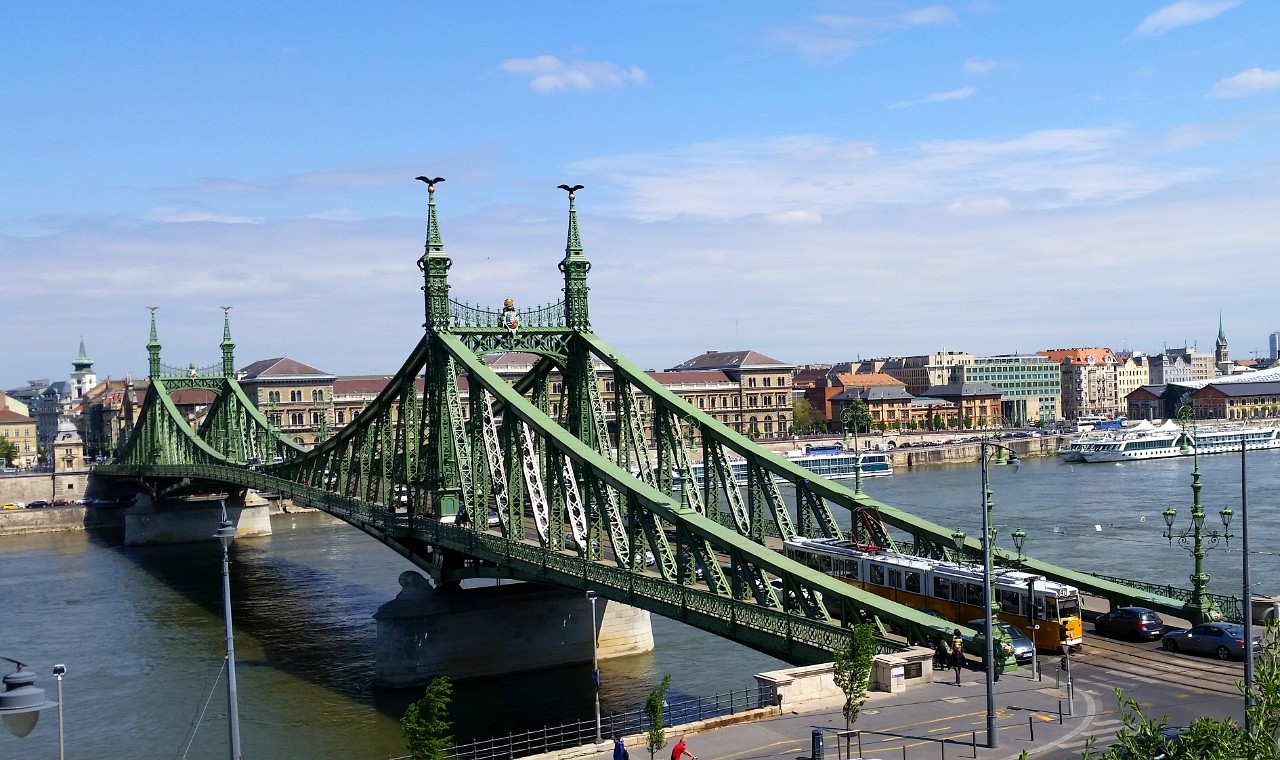
Liberty bridge
On the other side is the Great Market Hall, which makes a Gellért Hill walk a perfect loop walk from the center – crossing the Elizabeth Bridge to start and the Liberty Bridge to finish.
The Great Market Hall
With colorful Zsolnay roof tiles and beautiful brickwork, the huge Great Market Hall was completely damaged in WWII but restored to it’s original 1897 splendor in the 1990’s.
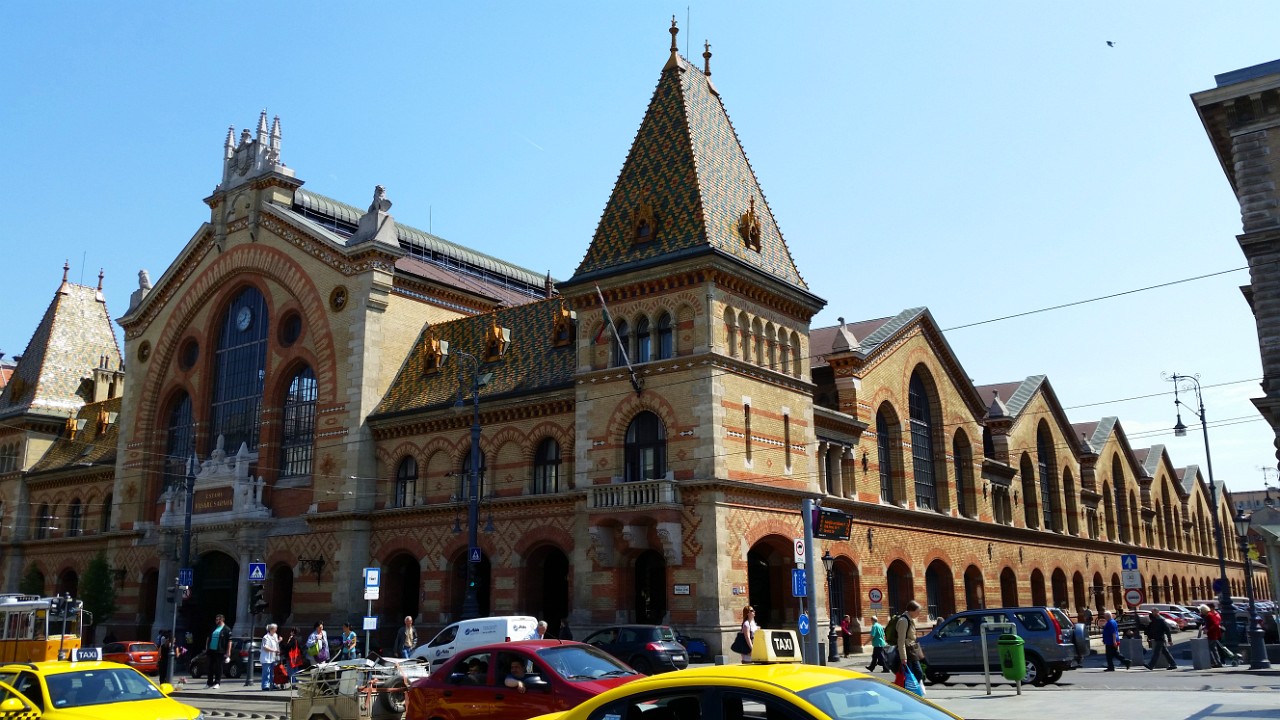
Central Market
Filled with all kinds of Hungarian specialty products, souvenirs, food stalls, tourists, and even real market shops in the basement level, it makes a great stop across the Liberty Bridge from a Gellért Hill walk!
Inside the Great Market Hall
The 100 meters long Great Market Hall, the largest and oldest indoor market in Budapest, is great for a stroll around to see just how many products you can make with Paprika…just kidding, although some delicious Hungarian Paprika salami was the one product we ended up buying.
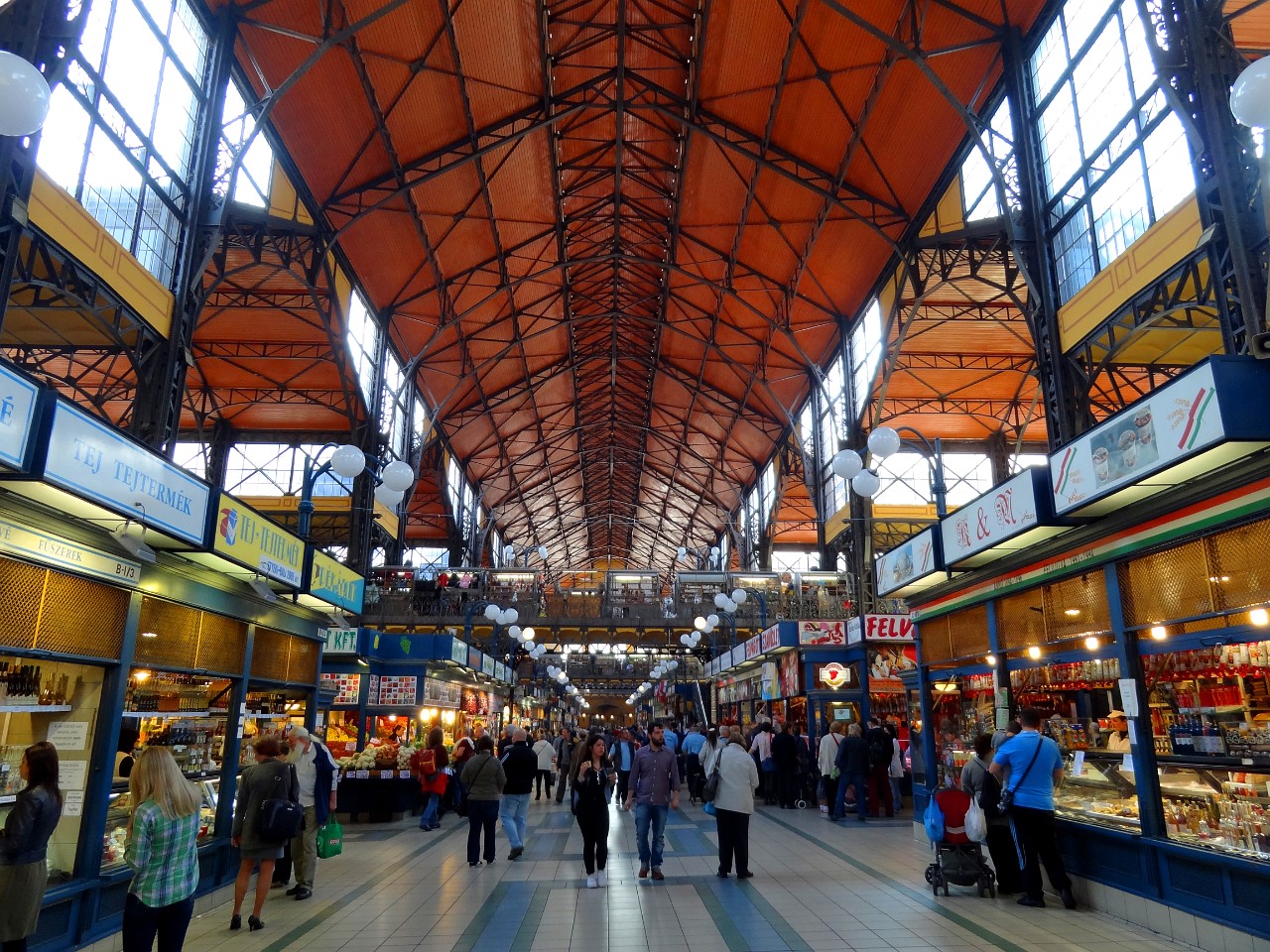
Central Market
Did you know that paprika is the best known ingredient in Hungarian cuisine?
Fovám tér – Across from the Great Market Hall
I love the grand Belle Époque architecture in Budapest, especially the colorful murals that decorate many facades, like on this elegant apartment building across from the Great Market Hall at Fovám tér.
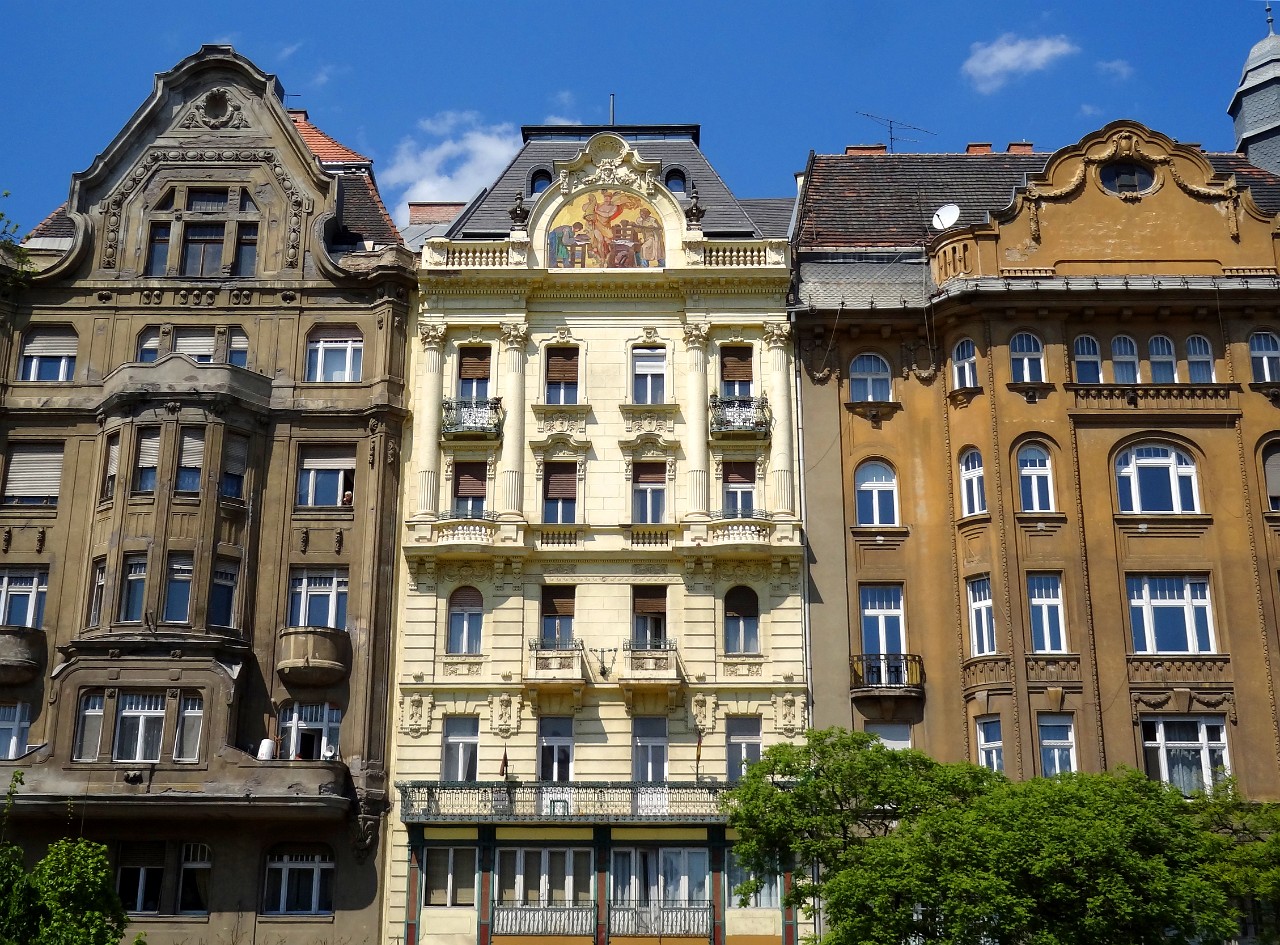
Fovam Ter
All throughout Budapest you’ll see many buildings beautifully maintained, but don’t be surprised to find a big mix – a bright and beautiful building next to one that showing a need for an infusion of capital to bring it back to its glory days.
Brudern House – Parisi-haz
The fantastic fantasy façade of the ornate 1913 Brudern House, also known as Párisi-haz (Paris House) for the shopping arcade that used to be in the lower level, the arcade was modeled after the Passage des Panoramas in Paris.
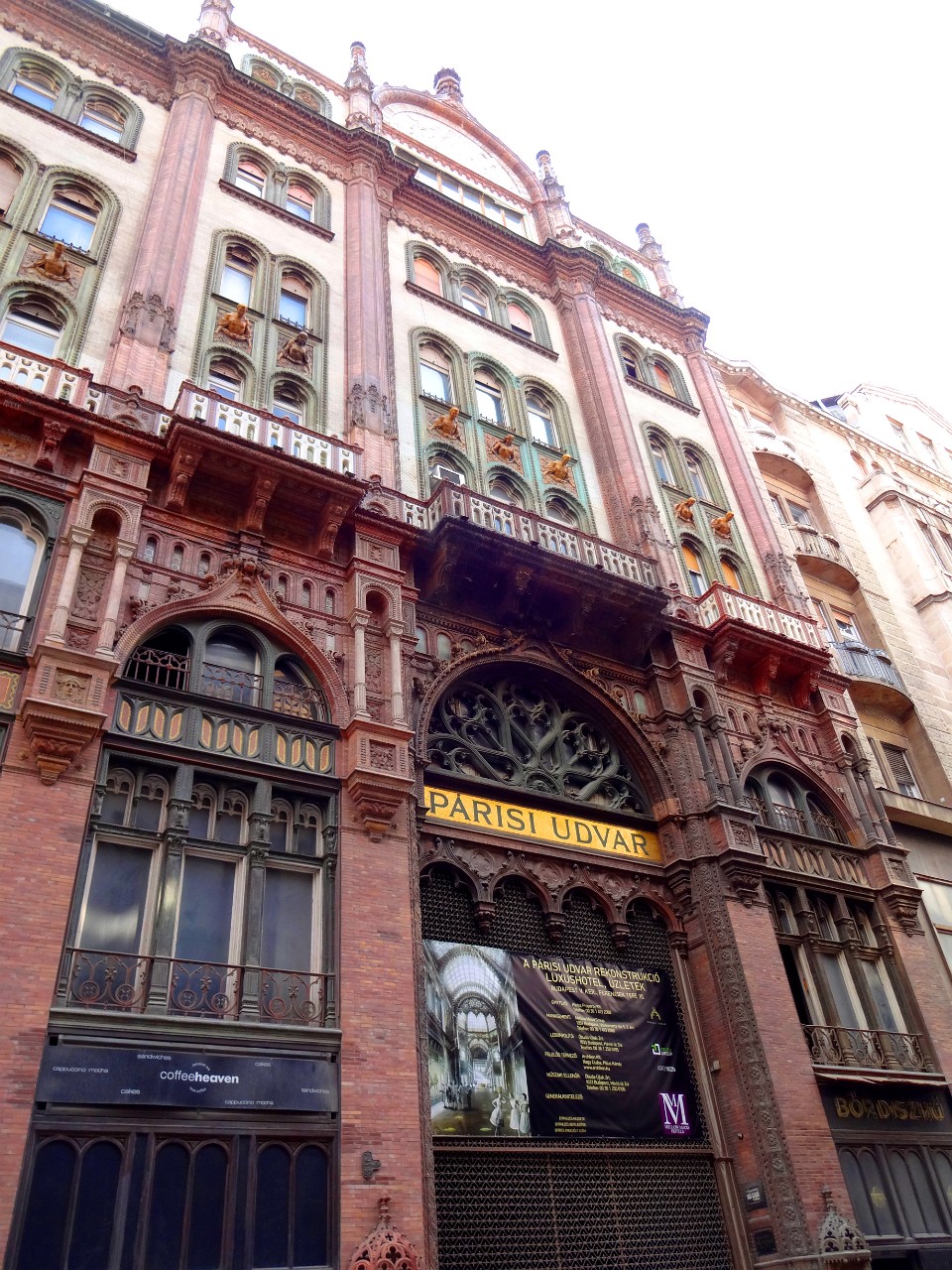
Brudern House
This is a terrific detour off of the famous pedestrian street Váci Utca on the way back to the center of Pest from a Gellért Hill walk. Don’t you love the statues looking down at you from above the windows?
Ferenciek Tere – Franciscan’s Square
Beautiful domes of grand buildings down Ferenciek tere (Franciscan’s Square), one of the oldest in Budapest.

Budapest domes Ferenciek square
The big beautiful tiled dome of the yellow University Library building is unmistakable, and in the top right foreground you can see one of the frilly ornate reddish-brown towers of the Brudern House, the facade featured in the previous photo. Fabulous architecture!
Budapest Parliament at Night
Have you ever been on a night time tour on the water? One of my favorite experiences in Budapest was the Danube tour boat at night to see all the magnificent buildings beautifully lit up and down both sides of the river.
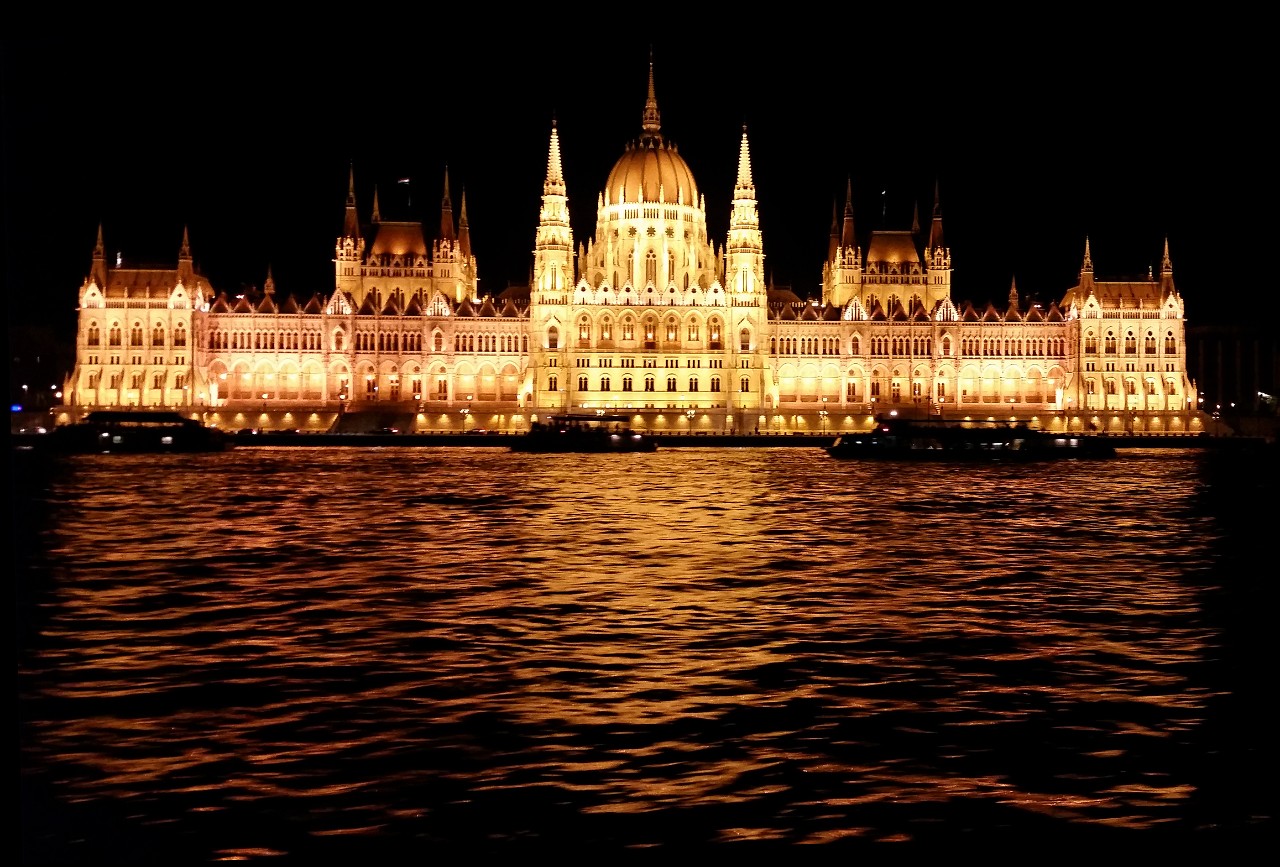
Budapest Parliament at night
If you want a seat outside get to the boat early to have your pick of a seat…oh, and make a reservation in advance for an evening tour, the best times fill up! Don’t miss it!
Exploring Budapest Wrap-up: The Hungarian language is a tongue twister but one word you’re sure to remember is Szia, a friendly cheerful word used for both Hi and Bye like the Italian Ciao. Plus it’s easy to remember because it’s pronounced See-ya, like see ya later.
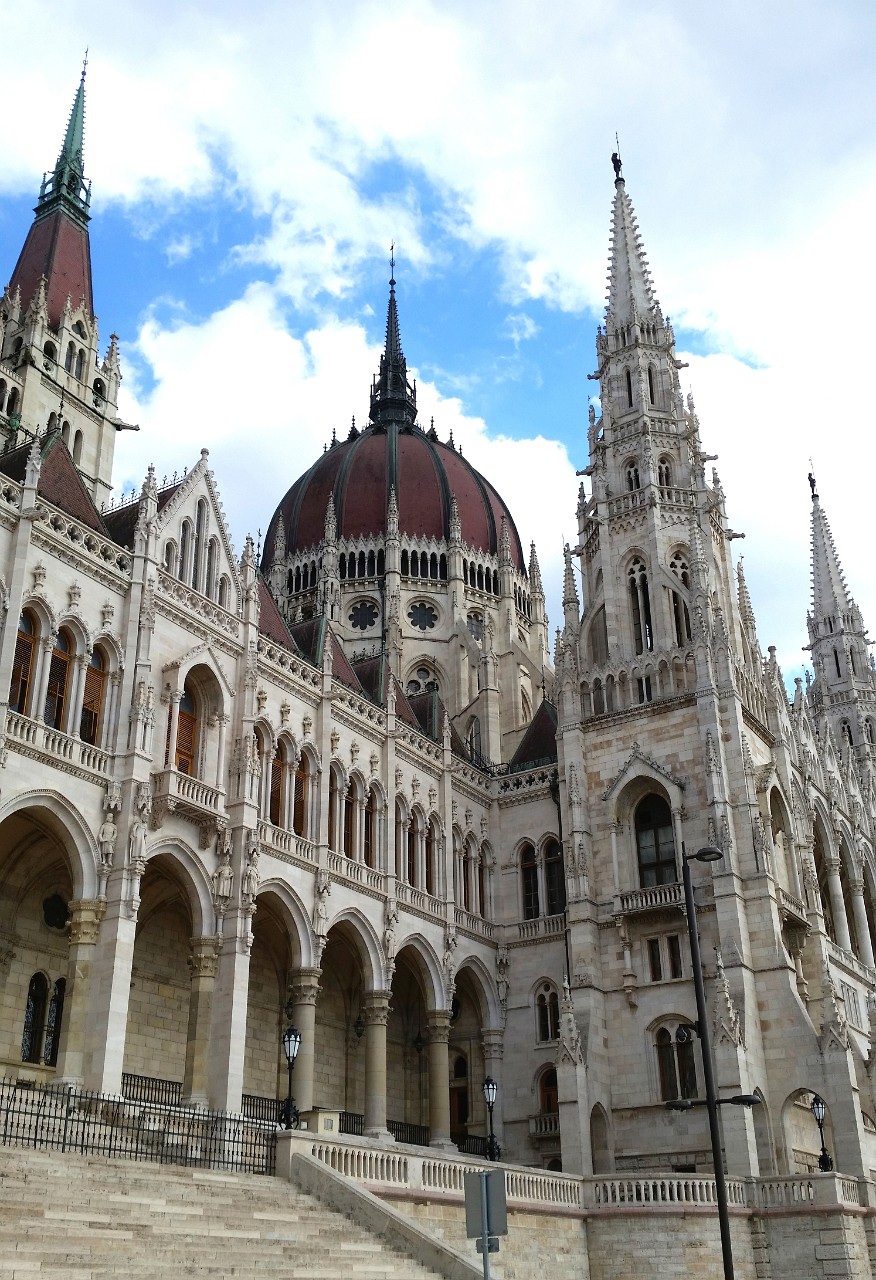
Parliament close up
Szia Budapest! A beautiful city with fabulous architecture, wonderful friendly people, and a whole lot of fascinating history to explore.
Follow me on my Instagram account Travelknowing for more Travel series, after all…knowing is everything!







